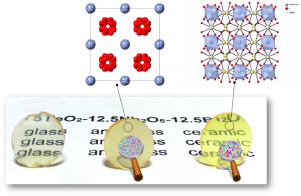Ask for a reprint
email :
* Give your email
2020
ACL
|
M.Dolhen, M.Allix, V.Sarou-Kanian, F.Fayon, C.Genevois, S.Chenu, P.E.Coulon, M.Colas, J.Cornette, J.R.Duclère, F.Brisset, O.Masson, P.Thomas, G.Delaizir, 'A comprehensive study of the glass / translucent anti-glass / transparent ceramic structural ordering in the Bi2O3-Nb2O5-TeO2 system', Acta Mater. 189 73-84 (2020) doi:10.1016/j.actamat.2020.02.062
The full and congruent crystallization of the Bi0.8Nb0.8Te2.4O8 (BNT) glass leads to perfectly transparent
ceramic in both the visible and near infrared ranges. While heating the parent glass, an intermediate structural
regime order � called anti-glass � that shows chemical inhomogeneity at the nanometer scale and
with a long-range cationic ordering while retaining a strong local anionic disorder is observed. Here, we
report on the crystallization sequence starting from the Bi0.8Nb0.8Te2.4O8 glass system and show that an
intermediate Bi0.8Nb0.8Te2.4O8 anti-glass phase (polymorph 1) is first formed, before transforming into a
more ordered and ceramic material (polymorph 2). In particular, we provide a comprehensive structural
study of the crossover between glass and its crystalline counterpart through intermediate steps. Similarities
and differences between the structures, microstructures of Bi0.8Nb0.8Te2.4O8 glass, anti-glass and ceramic
materials of identical composition are investigated in details at different length scales by X-ray and neutron
powder diffraction, SEM-EBSD, TEM, NMR and Raman spectroscopy. The optical properties of the anti-glass
and ceramic are discussed in correlation with the structure and microstructure observations. This study
paves the way for understanding the complex mechanisms at the origin of the full and congruent crystallization
from the parent glass.
|

|